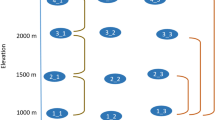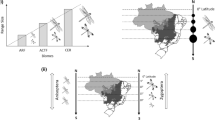Abstract
A standardized sampling method was used to evaluate turnover (β diversity) among cactus species assemblages along a 798 km long latitudinal megatransect across the Chihuahuan Desert Region, from north-central Mexico to southern Texas. A total of 71 cactus species were found along the megatransect, 66.2% of which appeared at low frequencies, mostly as a consequence of their highly discontinuous distribution pattern. At the scale the study was conducted, there was always species turnover among cactus assemblages. The rate of turnover among contiguous sites primarily fluctuated from low to medium, but when all site combinations were considered (contiguous and non-contiguous), medium β diversity values were predominant (β = 0.331–0.66); however, 25.4% of the site pair combinations registered high values (β = 0.661–1.0). Our results showed that turnover among cactus species assemblages in the CDR does not consist for the most part of a process of species succession in the geographic space. Instead, we concluded that the continuous spatial changes in cactus species composition are primarily explained by the commonly intermittent distribution patterns of the species, by the presence in the megatransect of species at the margin of their distribution range, and, to a lesser extent, by the existence of narrowly endemic species.







Similar content being viewed by others

References
Condit R, Pitman N, Leigh EG Jr, Chave J, Terborgh J, Foster RB, Núñez P, Aguilar S, Valencia R, Villa G, Muller-Landau HC, Losos E, Hubbell SP (2002) Beta-diversity in tropical forest trees. Science 295:666–669
Dinerstein E, Olson D, Atchley J, Loucks C, Contreras-Balderas S, Abell R, Iñigo E, Enkerlin E, Williams CE, Castilleja G (eds) (1999) Ecoregion-based conservation in the Chihuahuan Desert: a biological assessment and biodiversity vision. WWF, CONABIO, PRONATURA and ITESM, Washington, DC, USA
Goettsch B, Hernández HM (2006) Beta diversity and similarity among cactus assemblages in the Chihuahuan Desert. J Arid Environ 65:513–528
Gómez-Hinostrosa C, Hernández HM (2000) Diversity, geographical distribution, and conservation of Cactaceae in the Mier y Noriega region, Mexico. Biodivers Conserv 9:403–418
Harrison S, Ross SJ, Lawton JH (1992) Beta diversity on geographical gradients in Britain. J Anim Ecol 61:151–158
Henrickson J, Johnston MC (1986) Vegetation and community types of the Chihuahuan Desert. In: Barlow JC, Powell AM, Timmermann B (eds) Second symposium on the resources of the Chihuahuan Desert Region, United States and Mexico. Chihuahuan Desert Research Institute and Sul Ross State University. Alpine, Texas, USA, pp 20–39
Hernández HM (2006) La vida en los desiertos mexicanos. Fondo de Cultura Económica, Mexico City, Mexico, 188 pp
Hernández HM, Bárcenas RT (1995) Endangered cacti in the Chihuahuan Desert. I. Distribution patterns. Conserv Biol 9:1176–1190
Hernández HM, Bárcenas RT (1996) Endangered cacti in the Chihuahuan Desert. II. Biogeography and conservation. Conserv Biol 10:1200–1209
Hernández HM, Gómez-Hinostrosa C (2004) Studies on Mexican Cactaceae. IV. A new subspecies of Echinocereus palmeri Britton & Rose, first record of the species in the Chihuahuan Desert. Bradleya 22:1–8
Hernández HM, Gómez-Hinostrosa C (2005) Cactus diversity and endemism in the Chihuahuan Desert Region. In: Cartron JL, Felger R, Ceballos G (eds) Biodiversity and conservation in Northern Mexico. Oxford University Press, New York, USA, pp 264–275
Hernández HM, Navarro M (2007) A new method to estimate areas of occupancy using herbarium data. Biodivers Conserv 16:2457–2470
Hernández HM, Gómez-Hinostrosa C, Bárcenas RT (2001) Diversity, spatial arrangement, and endemism of Cactaceae in the Huizache area, a hot-spot in the Chihuahuan Desert. Biodivers Conserv 10:1097–1112
Hernández HM, Gómez-Hinostrosa C, Goettsch B (2004) Checklist of Chihuahuan Desert Cactaceae. Harvard Papers Bot 9:51–68
Johnston MC (1977) Brief resume of botanical, including vegetational, features of the Chihuahuan Desert Region with special emphasis on their uniqueness. In: Wauer RH, Riskind DH (eds) Transactions of the symposium on the biological resources of the Chihuahuan Desert Region, United States and Mexico. National Park Service, Washington, DC, USA, pp 335–359
Manly BFJ (1997) Randomization, bootstrap and Monte Carlo methods in biology, 2nd edn. Chapman and Hall, London
Mantel N (1967) The detection of disease clustering and a generalize regression approach. Cancer Res 27:209–220
Medellín-Leal F (1982) The Chihuahuan Desert. In: Bender GL (ed) Reference handbook on the deserts of North America. Greenwood Press, Westport, CT, USA, pp 321–372
Mittermeier RA, Goettsch C, Robles-Gil P, Pilgrim J, Fonseca G, Konstant WR, Brooks T (eds) (2002) Wilderness: earth’s last wild places. CEMEX, Mexico City, Mexico, 568 pp
Morafka DJ (1977) A biogeographical analysis of the Chihuahuan Desert through its herpetofauna. Biogeographica 9:1–313
Mourelle C, Ezcurra E (1997) Differentiation diversity of Argentine cacti and its relationship to environmental factors. J Veg Sci 8:547–558
Mueller-Dombois D, Ellenberg H (1974) Aims and methods of vegetation ecology. John Wiley and Sons, New York, USA, 547 pp
Schmidt RH Jr (1979) A climatic delineation of the “real” Chihuahuan Desert. J Arid Environ 2:243–250
Shreve F (1942) The desert vegetation of North America. Bot Rev 8:195–246
Wilson MV, Shmida A (1984) Measuring beta diversity with presence-absence data. J Ecol 72:1055–1064
Wiersma YF, Urban DL (2005) Beta diversity and nature reserve system design in the Yukon, Canada. Conserv Biol 19(4):1262–1272
Acknowledgments
We would like to thank Exequiel Ezcurra for constructive criticisms to the manuscript, Rolando Bárcenas for identifying some of the species of Grusonia, Raul Puente for assisting us and making the arrangements for fieldwork in the Big Bend area, and Alfredo Wong for support in the analysis of similarity. We also thank the officials at the Big Bend National Park for allowing us to conduct fieldwork in the area. Fieldwork associated to this project was carried out under collecting permits FLOR-0004 and FLOR-0094, provided by Secretaría del Medio Ambiente, Recursos Naturales y Pesca, Mexico.
Author information
Authors and Affiliations
Corresponding author
Appendices
Appendices
Rights and permissions
About this article
Cite this article
Hernández, H.M., Goettsch, B., Gómez-Hinostrosa, C. et al. Cactus species turnover and diversity along a latitudinal transect in the Chihuahuan Desert Region. Biodivers Conserv 17, 703–720 (2008). https://doi.org/10.1007/s10531-007-9303-2
Received:
Accepted:
Published:
Issue Date:
DOI: https://doi.org/10.1007/s10531-007-9303-2



